Deck 53: Introduction to Ecology Population Ecology
سؤال
سؤال
سؤال
سؤال
سؤال
سؤال
سؤال
سؤال
سؤال
سؤال
سؤال
سؤال
سؤال
سؤال
سؤال
سؤال
سؤال
سؤال
سؤال
سؤال
سؤال
سؤال
سؤال
سؤال
سؤال
سؤال
سؤال
سؤال
سؤال
سؤال
سؤال
سؤال
سؤال
سؤال
سؤال
سؤال
سؤال
سؤال
سؤال
سؤال
سؤال
سؤال
سؤال
سؤال
سؤال
سؤال
سؤال
سؤال
سؤال
سؤال
سؤال
سؤال
سؤال
سؤال
سؤال
سؤال
سؤال
سؤال
سؤال
سؤال
سؤال
سؤال
سؤال
سؤال
سؤال
سؤال
سؤال
سؤال
سؤال
سؤال
سؤال
سؤال
سؤال
سؤال
سؤال
سؤال
سؤال
سؤال
سؤال
سؤال

فتح الحزمة
قم بالتسجيل لفتح البطاقات في هذه المجموعة!
Unlock Deck
Unlock Deck
1/90
العب
ملء الشاشة (f)
Deck 53: Introduction to Ecology Population Ecology
1
Communities are composed of all of the:
A) communities of all the different populations that live together within an area.
B) ecosystems within the biosphere.
C) populations of all the different species that live together within an area.
D) various dispersal patterns of the different species within a given area.
E) population's females' combined reproductive capabilities within the same given unit of time.
A) communities of all the different populations that live together within an area.
B) ecosystems within the biosphere.
C) populations of all the different species that live together within an area.
D) various dispersal patterns of the different species within a given area.
E) population's females' combined reproductive capabilities within the same given unit of time.
C
2
The organisms associated with patches of floating ocean vegetation would be an example of:
A) random dispersion
B) density-independent distribution
C) uniform dispersion
D) density-dependent distribution
E) clumped dispersion
A) random dispersion
B) density-independent distribution
C) uniform dispersion
D) density-dependent distribution
E) clumped dispersion
E
3
Which of the following organisms would have the highest intrinsic rate of increase?
A) bacteria
B) blue whales
C) red grouse
D) elephants
E) humans
A) bacteria
B) blue whales
C) red grouse
D) elephants
E) humans
A
4
Which of the following relationships is incorrectly paired?
A) schooling fish − aggregated distribution
B) nesting seabirds − random dispersion
C) grove of aspen − clumped dispersion
D) flour beetle larvae − random dispersion
E) adult sand pine − uniform dispersion
A) schooling fish − aggregated distribution
B) nesting seabirds − random dispersion
C) grove of aspen − clumped dispersion
D) flour beetle larvae − random dispersion
E) adult sand pine − uniform dispersion

فتح الحزمة
افتح القفل للوصول البطاقات البالغ عددها 90 في هذه المجموعة.
فتح الحزمة
k this deck
5
____ is the least frequent of the dispersal patterns seen in nature.
A) Random dispersion
B) Aggregated distribution
C) Uniform dispersion
D) Density-dependent distribution
E) Clumped dispersion
A) Random dispersion
B) Aggregated distribution
C) Uniform dispersion
D) Density-dependent distribution
E) Clumped dispersion

فتح الحزمة
افتح القفل للوصول البطاقات البالغ عددها 90 في هذه المجموعة.
فتح الحزمة
k this deck
6
What would be the growth rate ( r ) of an island population of 1000 that has 30 births per 100 population, 20 death per 100 population, 5 immigrants per 100 population, and 10 emigrants per 100 population?
A) +5
B) − 50
C) +50
D) − 150
E) +150
A) +5
B) − 50
C) +50
D) − 150
E) +150

فتح الحزمة
افتح القفل للوصول البطاقات البالغ عددها 90 في هذه المجموعة.
فتح الحزمة
k this deck
7
Figure 53-1 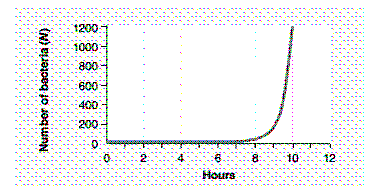 The graph in the accompanying figure would best be described as:
The graph in the accompanying figure would best be described as:
A) being characteristic of exponential growth.
B) being characteristic of arithmetic growth.
C) an S-shaped curve.
D) a J-shaped curve.
E) being a J-shaped curve characteristic of exponential growth.
 The graph in the accompanying figure would best be described as:
The graph in the accompanying figure would best be described as:A) being characteristic of exponential growth.
B) being characteristic of arithmetic growth.
C) an S-shaped curve.
D) a J-shaped curve.
E) being a J-shaped curve characteristic of exponential growth.

فتح الحزمة
افتح القفل للوصول البطاقات البالغ عددها 90 في هذه المجموعة.
فتح الحزمة
k this deck
8
When r = 0.00001, the population size:
A) will increase.
B) will decrease.
C) is stable.
D) may increase or decrease, depending on K .
E) may increase or decrease, depending on i .
A) will increase.
B) will decrease.
C) is stable.
D) may increase or decrease, depending on K .
E) may increase or decrease, depending on i .

فتح الحزمة
افتح القفل للوصول البطاقات البالغ عددها 90 في هذه المجموعة.
فتح الحزمة
k this deck
9
What term refers to the average rate at which organisms produce offspring?:
A) doubling time
B) natality
C) emigration
D) stasis
E) survivorship
A) doubling time
B) natality
C) emigration
D) stasis
E) survivorship

فتح الحزمة
افتح القفل للوصول البطاقات البالغ عددها 90 في هذه المجموعة.
فتح الحزمة
k this deck
10
Natural selection acts most directly on:
A) populations.
B) communities.
C) ecosystems.
D) the biosphere.
E) K- selected organisms.
A) populations.
B) communities.
C) ecosystems.
D) the biosphere.
E) K- selected organisms.

فتح الحزمة
افتح القفل للوصول البطاقات البالغ عددها 90 في هذه المجموعة.
فتح الحزمة
k this deck
11
At zero population growth:
A) b = d.
B) b > d.
C) b d.
D) r > 0.
E) r > K .
A) b = d.
B) b > d.
C) b d.
D) r > 0.
E) r > K .

فتح الحزمة
افتح القفل للوصول البطاقات البالغ عددها 90 في هذه المجموعة.
فتح الحزمة
k this deck
12
Biologists in which of the following applied disciplines must understand population ecology?
A) forestry
B) agronomy
C) wildlife management
D) forestry and agronomy
E) forestry, agronomy, and wildlife management
A) forestry
B) agronomy
C) wildlife management
D) forestry and agronomy
E) forestry, agronomy, and wildlife management

فتح الحزمة
افتح القفل للوصول البطاقات البالغ عددها 90 في هذه المجموعة.
فتح الحزمة
k this deck
13
Figure 53-1 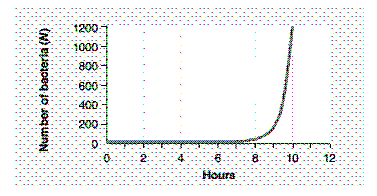 The equation that would best describe the curve in the accompanying figure is:
The equation that would best describe the curve in the accompanying figure is:
A) dN / dt = r .
B) dN / dt = N .
C) dN / dt = rN .
D) dN / dt = rN + I − e .
E) dN / dt = rN ( K − N ).
 The equation that would best describe the curve in the accompanying figure is:
The equation that would best describe the curve in the accompanying figure is:A) dN / dt = r .
B) dN / dt = N .
C) dN / dt = rN .
D) dN / dt = rN + I − e .
E) dN / dt = rN ( K − N ).

فتح الحزمة
افتح القفل للوصول البطاقات البالغ عددها 90 في هذه المجموعة.
فتح الحزمة
k this deck
14
Which of the following series correctly represents the hierarchical organization within ecology?
A) ecosystem → population → community → biosphere
B) biosphere → community → population → ecosystem
C) community → population → ecosystem → biosphere
D) population → community → ecosystem → biosphere
E) population → ecosystem → community → biosphere
A) ecosystem → population → community → biosphere
B) biosphere → community → population → ecosystem
C) community → population → ecosystem → biosphere
D) population → community → ecosystem → biosphere
E) population → ecosystem → community → biosphere

فتح الحزمة
افتح القفل للوصول البطاقات البالغ عددها 90 في هذه المجموعة.
فتح الحزمة
k this deck
15
When r = − 0.00057, the population size:
A) will increase.
B) will decrease.
C) is stable.
D) may increase or decrease, depending on K .
E) may increase or decrease, depending on i .
A) will increase.
B) will decrease.
C) is stable.
D) may increase or decrease, depending on K .
E) may increase or decrease, depending on i .

فتح الحزمة
افتح القفل للوصول البطاقات البالغ عددها 90 في هذه المجموعة.
فتح الحزمة
k this deck
16
The best definition of population density is the number of individuals:
A) of all species in a given area.
B) of one species in a given area.
C) in a given area at a given time.
D) of all species in a given area at a given time.
E) of one species in a given area at a given time.
A) of all species in a given area.
B) of one species in a given area.
C) in a given area at a given time.
D) of all species in a given area at a given time.
E) of one species in a given area at a given time.

فتح الحزمة
افتح القفل للوصول البطاقات البالغ عددها 90 في هذه المجموعة.
فتح الحزمة
k this deck
17
Which of the following consists of organisms, all of which share a common gene pool?
A) a community
B) a population
C) a biosphere
D) an ecosystem
E) a landscape
A) a community
B) a population
C) a biosphere
D) an ecosystem
E) a landscape

فتح الحزمة
افتح القفل للوصول البطاقات البالغ عددها 90 في هذه المجموعة.
فتح الحزمة
k this deck
18
Clumped dispersion is often influenced by:
A) the presence of strange groups.
B) sexual reproduction in plants or invertebrates.
C) unlimited seed dispersal in plants.
D) a patchy distribution of resources.
E) homogenous environments.
A) the presence of strange groups.
B) sexual reproduction in plants or invertebrates.
C) unlimited seed dispersal in plants.
D) a patchy distribution of resources.
E) homogenous environments.

فتح الحزمة
افتح القفل للوصول البطاقات البالغ عددها 90 في هذه المجموعة.
فتح الحزمة
k this deck
19
Which set of values would result in a population with a growth rate of zero?
A) b = 1000, d = 500, i = 750, e = 1000
B) b = 1000, d = 500, i = 1000, e = 1000
C) b = 1000, d = 500, i = 1500, e = 1000
D) b = 1000, d = 500, i = 0, e = 1000
E) b = 1000, d = 500, i = 500, e = 1000
A) b = 1000, d = 500, i = 750, e = 1000
B) b = 1000, d = 500, i = 1000, e = 1000
C) b = 1000, d = 500, i = 1500, e = 1000
D) b = 1000, d = 500, i = 0, e = 1000
E) b = 1000, d = 500, i = 500, e = 1000

فتح الحزمة
افتح القفل للوصول البطاقات البالغ عددها 90 في هذه المجموعة.
فتح الحزمة
k this deck
20
The logistic equation:
A) models a J-shaped growth curve.
B) takes into account the carrying capacity of the environment.
C) predicts continued exponential growth.
D) characterizes the uncontrolled growth of a population.
E) models a K -shaped growth curve.
A) models a J-shaped growth curve.
B) takes into account the carrying capacity of the environment.
C) predicts continued exponential growth.
D) characterizes the uncontrolled growth of a population.
E) models a K -shaped growth curve.

فتح الحزمة
افتح القفل للوصول البطاقات البالغ عددها 90 في هذه المجموعة.
فتح الحزمة
k this deck
21
When the size of a population greatly exceeds K , we can expect that the population will:
A) rapidly increase.
B) slowly increase.
C) slowly decrease.
D) rapidly decrease.
E) stabilize.
A) rapidly increase.
B) slowly increase.
C) slowly decrease.
D) rapidly decrease.
E) stabilize.

فتح الحزمة
افتح القفل للوصول البطاقات البالغ عددها 90 في هذه المجموعة.
فتح الحزمة
k this deck
22
Figure 53-3 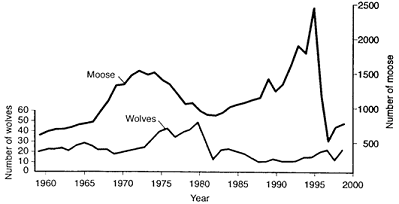 Based on the accompanying figure, the decline in the moose population in 1996 was most likely due to a(n):
Based on the accompanying figure, the decline in the moose population in 1996 was most likely due to a(n):
A) predictable increase in the wolf population.
B) unpredictable increase in the wolf population.
C) decrease in the intrinsic rate of increase for the moose population.
D) decline in the food supply.
E) unknown disease organism.
 Based on the accompanying figure, the decline in the moose population in 1996 was most likely due to a(n):
Based on the accompanying figure, the decline in the moose population in 1996 was most likely due to a(n):A) predictable increase in the wolf population.
B) unpredictable increase in the wolf population.
C) decrease in the intrinsic rate of increase for the moose population.
D) decline in the food supply.
E) unknown disease organism.

فتح الحزمة
افتح القفل للوصول البطاقات البالغ عددها 90 في هذه المجموعة.
فتح الحزمة
k this deck
23
The moose population on Isle Royale is an example of:
A) interspecific exploitation competition.
B) intraspecific exploitation competition.
C) interspecific contest competition.
D) intraspecific contest competition.
E) both intraspecific contest competition and scramble competition.
A) interspecific exploitation competition.
B) intraspecific exploitation competition.
C) interspecific contest competition.
D) intraspecific contest competition.
E) both intraspecific contest competition and scramble competition.

فتح الحزمة
افتح القفل للوصول البطاقات البالغ عددها 90 في هذه المجموعة.
فتح الحزمة
k this deck
24
Density-independent factors:
A) influence population size and are in turn influenced by changes in population density.
B) may be the result of intense interspecific competition.
C) are typically abiotic.
D) may include parasites.
E) may include diseases.
A) influence population size and are in turn influenced by changes in population density.
B) may be the result of intense interspecific competition.
C) are typically abiotic.
D) may include parasites.
E) may include diseases.

فتح الحزمة
افتح القفل للوصول البطاقات البالغ عددها 90 في هذه المجموعة.
فتح الحزمة
k this deck
25
Figure 53-3 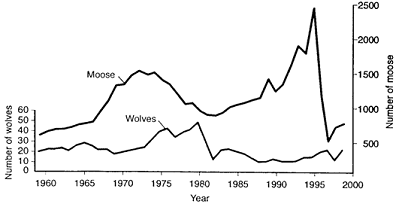 According to the data in the accompanying figure, the cause of the decline of the wolf population in 1982 was:
According to the data in the accompanying figure, the cause of the decline of the wolf population in 1982 was:
A) a sharp decrease in food supply.
B) a decrease in the intrinsic rate of increase for the wolf population.
C) competition with a newly introduced predator.
D) introduction of a disease organism.
E) cannot be determined from the data provided.
 According to the data in the accompanying figure, the cause of the decline of the wolf population in 1982 was:
According to the data in the accompanying figure, the cause of the decline of the wolf population in 1982 was:A) a sharp decrease in food supply.
B) a decrease in the intrinsic rate of increase for the wolf population.
C) competition with a newly introduced predator.
D) introduction of a disease organism.
E) cannot be determined from the data provided.

فتح الحزمة
افتح القفل للوصول البطاقات البالغ عددها 90 في هذه المجموعة.
فتح الحزمة
k this deck
26
The potential capacity to produce offspring is called:
A) life history traits.
B) fitness.
C) age structure.
D) density.
E) fecundity.
A) life history traits.
B) fitness.
C) age structure.
D) density.
E) fecundity.

فتح الحزمة
افتح القفل للوصول البطاقات البالغ عددها 90 في هذه المجموعة.
فتح الحزمة
k this deck
27
Generally, r -selected organisms exhibit:
A) short life spans and early maturity.
B) long life spans and extended parental care of offspring.
C) long development time to maturity, but small body size.
D) large body size and extended parental care of offspring.
E) large body size, but short life spans.
A) short life spans and early maturity.
B) long life spans and extended parental care of offspring.
C) long development time to maturity, but small body size.
D) large body size and extended parental care of offspring.
E) large body size, but short life spans.

فتح الحزمة
افتح القفل للوصول البطاقات البالغ عددها 90 في هذه المجموعة.
فتح الحزمة
k this deck
28
What is a typical feature of K -selected organisms?
A) early reproduction
B) fast development
C) a low reproductive rate
D) small body size
E) little parental care of offspring
A) early reproduction
B) fast development
C) a low reproductive rate
D) small body size
E) little parental care of offspring

فتح الحزمة
افتح القفل للوصول البطاقات البالغ عددها 90 في هذه المجموعة.
فتح الحزمة
k this deck
29
Populations that experience significant contest competition:
A) show small changes in population size over time.
B) show great changes in population size over time.
C) are particularly susceptible to extinction.
D) show little intraspecific competition.
E) are characteristic of environments with abundant resources.
A) show small changes in population size over time.
B) show great changes in population size over time.
C) are particularly susceptible to extinction.
D) show little intraspecific competition.
E) are characteristic of environments with abundant resources.

فتح الحزمة
افتح القفل للوصول البطاقات البالغ عددها 90 في هذه المجموعة.
فتح الحزمة
k this deck
30
Which factors are an example of a negative feedback system?
A) density dependent
B) density independent
C) intraspecific competition
D) interspecific competition
E) scramble competition
A) density dependent
B) density independent
C) intraspecific competition
D) interspecific competition
E) scramble competition

فتح الحزمة
افتح القفل للوصول البطاقات البالغ عددها 90 في هذه المجموعة.
فتح الحزمة
k this deck
31
Iteroparity is common in which of the following organisms?
A) perennial herbaceous plants
B) most insects
C) agaves
D) most invertebrates
E) Pacific salmon
A) perennial herbaceous plants
B) most insects
C) agaves
D) most invertebrates
E) Pacific salmon

فتح الحزمة
افتح القفل للوصول البطاقات البالغ عددها 90 في هذه المجموعة.
فتح الحزمة
k this deck
32
Which of the following would increase population size?
A) natality
B) mortality
C) emigration
D) an r less than 0
E) an r equal to 0
A) natality
B) mortality
C) emigration
D) an r less than 0
E) an r equal to 0

فتح الحزمة
افتح القفل للوصول البطاقات البالغ عددها 90 في هذه المجموعة.
فتح الحزمة
k this deck
33
Figure 53-2 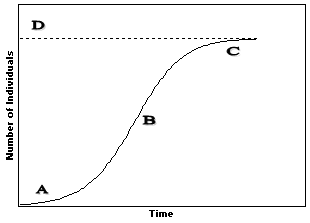 On the accompanying figure, identify the point that indicates the carrying capacity for this population.
On the accompanying figure, identify the point that indicates the carrying capacity for this population.
A) A
B) B
C) C
D) D
E) Cannot be determined from this graph.
 On the accompanying figure, identify the point that indicates the carrying capacity for this population.
On the accompanying figure, identify the point that indicates the carrying capacity for this population.A) A
B) B
C) C
D) D
E) Cannot be determined from this graph.

فتح الحزمة
افتح القفل للوصول البطاقات البالغ عددها 90 في هذه المجموعة.
فتح الحزمة
k this deck
34
Figure 53-2 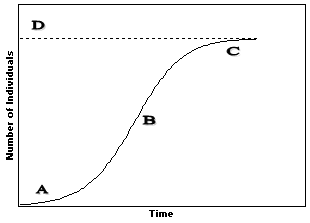 The accompanying figure models a(n) __________-shaped growth curve.
The accompanying figure models a(n) __________-shaped growth curve.
A) J
B) S
C) r
D) K
E) b
 The accompanying figure models a(n) __________-shaped growth curve.
The accompanying figure models a(n) __________-shaped growth curve.A) J
B) S
C) r
D) K
E) b

فتح الحزمة
افتح القفل للوصول البطاقات البالغ عددها 90 في هذه المجموعة.
فتح الحزمة
k this deck
35
Figure 53-5 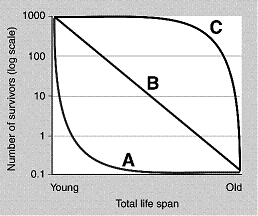 Refer to the accompanying figure. A population that produces a large number of offspring, but the offspring must survive independently, would be represented by the curve labeled:
Refer to the accompanying figure. A population that produces a large number of offspring, but the offspring must survive independently, would be represented by the curve labeled:
A) A
B) B
C) C
D) either A or B.
E) either A, B, or C.
 Refer to the accompanying figure. A population that produces a large number of offspring, but the offspring must survive independently, would be represented by the curve labeled:
Refer to the accompanying figure. A population that produces a large number of offspring, but the offspring must survive independently, would be represented by the curve labeled:A) A
B) B
C) C
D) either A or B.
E) either A, B, or C.

فتح الحزمة
افتح القفل للوصول البطاقات البالغ عددها 90 في هذه المجموعة.
فتح الحزمة
k this deck
36
Figure 53-5  Refer to the accompanying figure. How would the survivorship curve for elephants be represented?
Refer to the accompanying figure. How would the survivorship curve for elephants be represented?
A) The curve A
B) The curve B
C) The curve C
D) Either A or C, depending on the species
E) Elephant populations would be better represented by a curve falling between A and B.
 Refer to the accompanying figure. How would the survivorship curve for elephants be represented?
Refer to the accompanying figure. How would the survivorship curve for elephants be represented?A) The curve A
B) The curve B
C) The curve C
D) Either A or C, depending on the species
E) Elephant populations would be better represented by a curve falling between A and B.

فتح الحزمة
افتح القفل للوصول البطاقات البالغ عددها 90 في هذه المجموعة.
فتح الحزمة
k this deck
37
The growth rate of a population is expressed as:
A) b − d .
B) i − e .
C) K − N .
D) dN / r .
E) ( K − N ) / K .
A) b − d .
B) i − e .
C) K − N .
D) dN / r .
E) ( K − N ) / K .

فتح الحزمة
افتح القفل للوصول البطاقات البالغ عددها 90 في هذه المجموعة.
فتح الحزمة
k this deck
38
Two members of the same species compete for a limited resource, resulting in equal sharing of the limited resource. What is this called?
A) interspecific scramble competition
B) intraspecific scramble competition
C) interspecific contest competition
D) intraspecific contest competition
E) density-independent competition
A) interspecific scramble competition
B) intraspecific scramble competition
C) interspecific contest competition
D) intraspecific contest competition
E) density-independent competition

فتح الحزمة
افتح القفل للوصول البطاقات البالغ عددها 90 في هذه المجموعة.
فتح الحزمة
k this deck
39
Figure 53-2 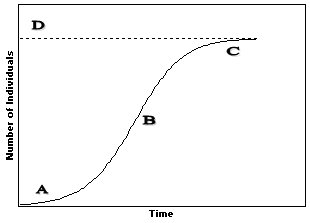 Refer to the accompanying figure. At which point on the graph is the population increasing exponentially?
Refer to the accompanying figure. At which point on the graph is the population increasing exponentially?
A) A
B) B
C) C
D) D
E) There is no exponential increase on this graph.
 Refer to the accompanying figure. At which point on the graph is the population increasing exponentially?
Refer to the accompanying figure. At which point on the graph is the population increasing exponentially?A) A
B) B
C) C
D) D
E) There is no exponential increase on this graph.

فتح الحزمة
افتح القفل للوصول البطاقات البالغ عددها 90 في هذه المجموعة.
فتح الحزمة
k this deck
40
An example of a density-dependent factor that influences the size of a population is:
A) rainfall.
B) temperature.
C) a fire.
D) parasites.
E) an earthquake.
A) rainfall.
B) temperature.
C) a fire.
D) parasites.
E) an earthquake.

فتح الحزمة
افتح القفل للوصول البطاقات البالغ عددها 90 في هذه المجموعة.
فتح الحزمة
k this deck
41
____ generally have greater population densities than less suitable sites.
A) Metahabitats
B) Sink habitats
C) Source populations
D) Source habitats
E) K -selected populations
A) Metahabitats
B) Sink habitats
C) Source populations
D) Source habitats
E) K -selected populations

فتح الحزمة
افتح القفل للوصول البطاقات البالغ عددها 90 في هذه المجموعة.
فتح الحزمة
k this deck
42
The average number of children born to a woman during her lifetime is known as:
A) age structure.
B) replacement-level fertility.
C) natality.
D) total fertility rate.
E) infant mortality rate.
A) age structure.
B) replacement-level fertility.
C) natality.
D) total fertility rate.
E) infant mortality rate.

فتح الحزمة
افتح القفل للوصول البطاقات البالغ عددها 90 في هذه المجموعة.
فتح الحزمة
k this deck
43
Figure 53-4  Based on the accompanying figure, which of the following age intervals has the highest death rate?
Based on the accompanying figure, which of the following age intervals has the highest death rate?
A) 0 − 1
B) 1 − 2
C) 2 − 3
D) 3 − 4
E) 4 − 5
 Based on the accompanying figure, which of the following age intervals has the highest death rate?
Based on the accompanying figure, which of the following age intervals has the highest death rate?A) 0 − 1
B) 1 − 2
C) 2 − 3
D) 3 − 4
E) 4 − 5

فتح الحزمة
افتح القفل للوصول البطاقات البالغ عددها 90 في هذه المجموعة.
فتح الحزمة
k this deck
44
By the end of the 21st century, it is expected that the human population will:
A) increase at the fastest rate in the highly developed countries.
B) increase at the fastest rate in the less developed countries.
C) increase at similar rates in all countries.
D) decrease at similar rates in all countries.
E) achieve zero population growth.
A) increase at the fastest rate in the highly developed countries.
B) increase at the fastest rate in the less developed countries.
C) increase at similar rates in all countries.
D) decrease at similar rates in all countries.
E) achieve zero population growth.

فتح الحزمة
افتح القفل للوصول البطاقات البالغ عددها 90 في هذه المجموعة.
فتح الحزمة
k this deck
45
A population that is divided into several local populations among which individuals occasionally disperse (emigrate and immigrate) is known as a:
A) metapopulation.
B) life table.
C) survivorship curve.
D) source population.
E) sink population.
A) metapopulation.
B) life table.
C) survivorship curve.
D) source population.
E) sink population.

فتح الحزمة
افتح القفل للوصول البطاقات البالغ عددها 90 في هذه المجموعة.
فتح الحزمة
k this deck
46
Figure 53-6 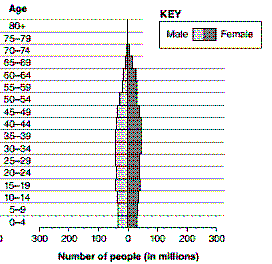 Refer to the accompanying figure. Assuming the pattern remains the same, what will the population experience in 50 years?
Refer to the accompanying figure. Assuming the pattern remains the same, what will the population experience in 50 years?
A) slow growth
B) rapid growth
C) steady state growth
D) negative growth
E) No prediction can be made using these data.
 Refer to the accompanying figure. Assuming the pattern remains the same, what will the population experience in 50 years?
Refer to the accompanying figure. Assuming the pattern remains the same, what will the population experience in 50 years?A) slow growth
B) rapid growth
C) steady state growth
D) negative growth
E) No prediction can be made using these data.

فتح الحزمة
افتح القفل للوصول البطاقات البالغ عددها 90 في هذه المجموعة.
فتح الحزمة
k this deck
47
Figure 53-4 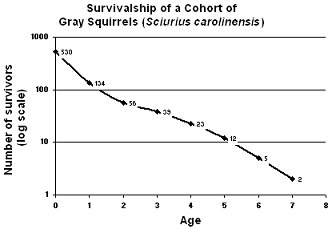 The accompanying figure is representative of:
The accompanying figure is representative of:
A) exponential growth.
B) iteroparity.
C) Type I survivorship.
D) Type III survivorship.
E) Type II survivorship.
 The accompanying figure is representative of:
The accompanying figure is representative of:A) exponential growth.
B) iteroparity.
C) Type I survivorship.
D) Type III survivorship.
E) Type II survivorship.

فتح الحزمة
افتح القفل للوصول البطاقات البالغ عددها 90 في هذه المجموعة.
فتح الحزمة
k this deck
48
In a human population with a high proportion of prereproductive individuals, the population will:
A) continue to increase even if the fertility rate is at replacement levels.
B) decline even if the fertility rate is at replacement levels.
C) increase only if the fertility rate is above replacement levels.
D) decline only if the replacement level fertility rate changes.
E) reach ZPG sooner than with a low proportion of prereproductive individuals.
A) continue to increase even if the fertility rate is at replacement levels.
B) decline even if the fertility rate is at replacement levels.
C) increase only if the fertility rate is above replacement levels.
D) decline only if the replacement level fertility rate changes.
E) reach ZPG sooner than with a low proportion of prereproductive individuals.

فتح الحزمة
افتح القفل للوصول البطاقات البالغ عددها 90 في هذه المجموعة.
فتح الحزمة
k this deck
49
Which of the following pairs is incorrectly matched?
A) highly developed countries − infant mortality rate close to 7 per 1000
B) moderately developed countries − fertility rate near 2
C) less developed countries − fertility rate near 5
D) worldwide − 27% of the population is less than 15 years old
E) United States − doubling time 100 years
A) highly developed countries − infant mortality rate close to 7 per 1000
B) moderately developed countries − fertility rate near 2
C) less developed countries − fertility rate near 5
D) worldwide − 27% of the population is less than 15 years old
E) United States − doubling time 100 years

فتح الحزمة
افتح القفل للوصول البطاقات البالغ عددها 90 في هذه المجموعة.
فتح الحزمة
k this deck
50
The Earth's carrying capacity is:
A) 1 billion.
B) 1 million.
C) 4 billion.
D) 16 billion.
E) unknown.
A) 1 billion.
B) 1 million.
C) 4 billion.
D) 16 billion.
E) unknown.

فتح الحزمة
افتح القفل للوصول البطاقات البالغ عددها 90 في هذه المجموعة.
فتح الحزمة
k this deck
51
The world human population has increased dramatically during the past few centuries due to:
A) increased immigration.
B) increased emigration.
C) decreased death rates.
D) increased birth rates.
E) decreased birth rates.
A) increased immigration.
B) increased emigration.
C) decreased death rates.
D) increased birth rates.
E) decreased birth rates.

فتح الحزمة
افتح القفل للوصول البطاقات البالغ عددها 90 في هذه المجموعة.
فتح الحزمة
k this deck
52
Tawny owls (Strix aluco) pair-bond for life, with both members of a pair living and hunting in adjacent, well-defined territories. Their reproduction is regulated in accordance with the resources, especially the food supply, present in their territories. Tawny owls can best described as:
A) r strategists.
B) K strategists.
C) fecundists.
D) life historists.
E) scramblers.
A) r strategists.
B) K strategists.
C) fecundists.
D) life historists.
E) scramblers.

فتح الحزمة
افتح القفل للوصول البطاقات البالغ عددها 90 في هذه المجموعة.
فتح الحزمة
k this deck
53
What British clergyman and economist was one of the first to recognize that the human population cannot continue to increase indefinitely?
A) Malthus
B) Gause
C) Schoener
D) Peterson
E) Hastings
A) Malthus
B) Gause
C) Schoener
D) Peterson
E) Hastings

فتح الحزمة
افتح القفل للوصول البطاقات البالغ عددها 90 في هذه المجموعة.
فتح الحزمة
k this deck
54
Surplus individuals in the ____ disperse and find another habitat in which to settle and reproduce.
A) metahabitats
B) sink habitats
C) landscape
D) source habitats
E) K -selected habitats.
A) metahabitats
B) sink habitats
C) landscape
D) source habitats
E) K -selected habitats.

فتح الحزمة
افتح القفل للوصول البطاقات البالغ عددها 90 في هذه المجموعة.
فتح الحزمة
k this deck
55
A human population that is shrinking would be characterized by a(n):
A) large proportion of prereproductive individuals.
B) small proportion of prereproductive individuals.
C) large proportion of reproductive individuals.
D) equal number of individuals of all age groups.
E) small proportion of postreproductive individuals.
A) large proportion of prereproductive individuals.
B) small proportion of prereproductive individuals.
C) large proportion of reproductive individuals.
D) equal number of individuals of all age groups.
E) small proportion of postreproductive individuals.

فتح الحزمة
افتح القفل للوصول البطاقات البالغ عددها 90 في هذه المجموعة.
فتح الحزمة
k this deck
56
Less-developed countries are most likely to be characterized by:
A) low fertility rates.
B) high GNI PPPs.
C) low doubling times.
D) high use of contraception.
E) high infant mortality rates.
A) low fertility rates.
B) high GNI PPPs.
C) low doubling times.
D) high use of contraception.
E) high infant mortality rates.

فتح الحزمة
افتح القفل للوصول البطاقات البالغ عددها 90 في هذه المجموعة.
فتح الحزمة
k this deck
57
Figure 53-6 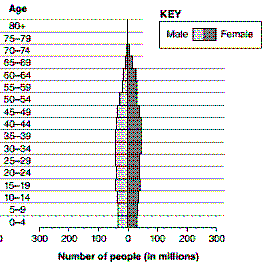 Figure 53-6 represents the age structure diagram of:
Figure 53-6 represents the age structure diagram of:
A) the transition stage.
B) the preindustrial state.
C) a moderately developed country.
D) a developing country.
E) a highly developed country.
 Figure 53-6 represents the age structure diagram of:
Figure 53-6 represents the age structure diagram of:A) the transition stage.
B) the preindustrial state.
C) a moderately developed country.
D) a developing country.
E) a highly developed country.

فتح الحزمة
افتح القفل للوصول البطاقات البالغ عددها 90 في هذه المجموعة.
فتح الحزمة
k this deck
58
Organisms such as oysters or fish that produce millions of eggs per year may be characterized as:
A) r -selected and having a type I survivorship curve.
B) K -selected and having a type I survivorship curve.
C) r -selected and having a type II survivorship curve.
D) K -selected and having a type II survivorship curve.
E) r -selected and having a type III survivorship curve.
A) r -selected and having a type I survivorship curve.
B) K -selected and having a type I survivorship curve.
C) r -selected and having a type II survivorship curve.
D) K -selected and having a type II survivorship curve.
E) r -selected and having a type III survivorship curve.

فتح الحزمة
افتح القفل للوصول البطاقات البالغ عددها 90 في هذه المجموعة.
فتح الحزمة
k this deck
59
____ are good habitats where local reproductive success is greater than local mortality.
A) Metahabitats
B) Sink habitats
C) Source populations
D) Source habitats
E) K -selected habitats
A) Metahabitats
B) Sink habitats
C) Source populations
D) Source habitats
E) K -selected habitats

فتح الحزمة
افتح القفل للوصول البطاقات البالغ عددها 90 في هذه المجموعة.
فتح الحزمة
k this deck
60
In a population characterized by type III survivorship, the probability of survival ____ with age.
A) increases
B) decreases
C) does not change
D) first decreases then increases
E) first increases then decreases
A) increases
B) decreases
C) does not change
D) first decreases then increases
E) first increases then decreases

فتح الحزمة
افتح القفل للوصول البطاقات البالغ عددها 90 في هذه المجموعة.
فتح الحزمة
k this deck
61
A killing frost is an example of a density- independent factor.

فتح الحزمة
افتح القفل للوصول البطاقات البالغ عددها 90 في هذه المجموعة.
فتح الحزمة
k this deck
62
Territoriality often results in clumped dispersion.

فتح الحزمة
افتح القفل للوصول البطاقات البالغ عددها 90 في هذه المجموعة.
فتح الحزمة
k this deck
63
Sketch an exponential growth curve with correctly labeled axes. Identify two organisms and the conditions under which they might demonstrate such growth.

فتح الحزمة
افتح القفل للوصول البطاقات البالغ عددها 90 في هذه المجموعة.
فتح الحزمة
k this deck
64
Most insects and invertebrates are said to be iteroparous .

فتح الحزمة
افتح القفل للوصول البطاقات البالغ عددها 90 في هذه المجموعة.
فتح الحزمة
k this deck
65
Write out the growth equation including the following factors: natality, mortality, immigration, and emigration. Provide a one-sentence explanation for the impact of each of these factors on the population growth rate.

فتح الحزمة
افتح القفل للوصول البطاقات البالغ عددها 90 في هذه المجموعة.
فتح الحزمة
k this deck
66
A(n) exponential growth curve has a J shape.

فتح الحزمة
افتح القفل للوصول البطاقات البالغ عددها 90 في هذه المجموعة.
فتح الحزمة
k this deck
67
Oysters have a(n) Type-II survivorship curve.

فتح الحزمة
افتح القفل للوصول البطاقات البالغ عددها 90 في هذه المجموعة.
فتح الحزمة
k this deck
68
The most common spacing is random dispersion.

فتح الحزمة
افتح القفل للوصول البطاقات البالغ عددها 90 في هذه المجموعة.
فتح الحزمة
k this deck
69
An example of a density- independent factor is predation.

فتح الحزمة
افتح القفل للوصول البطاقات البالغ عددها 90 في هذه المجموعة.
فتح الحزمة
k this deck
70
Members of a(n) r-selected species typically have a short lifespan.

فتح الحزمة
افتح القفل للوصول البطاقات البالغ عددها 90 في هذه المجموعة.
فتح الحزمة
k this deck
71
A density- dependent factor is an example of a negative feedback system.

فتح الحزمة
افتح القفل للوصول البطاقات البالغ عددها 90 في هذه المجموعة.
فتح الحزمة
k this deck
72
In Type-I survivorship, the young have a high probability of surviving.

فتح الحزمة
افتح القفل للوصول البطاقات البالغ عددها 90 في هذه المجموعة.
فتح الحزمة
k this deck
73
Compare and contrast Type I and Type III survivorship curves. Sketch a correctly labeled graph to support your comparison. BONUS: Identify two organisms that represent each of the two types of survivorship strategies discussed here.

فتح الحزمة
افتح القفل للوصول البطاقات البالغ عددها 90 في هذه المجموعة.
فتح الحزمة
k this deck
74
Scramble competition results when all individuals in a population share the limited resources.

فتح الحزمة
افتح القفل للوصول البطاقات البالغ عددها 90 في هذه المجموعة.
فتح الحزمة
k this deck
75
K strategists typically produce large numbers of offspring.

فتح الحزمة
افتح القفل للوصول البطاقات البالغ عددها 90 في هذه المجموعة.
فتح الحزمة
k this deck
76
Species that exhibit repeated reproductive cycles are said to be semelparous .

فتح الحزمة
افتح القفل للوصول البطاقات البالغ عددها 90 في هذه المجموعة.
فتح الحزمة
k this deck
77
A(n) exponential growth curve levels off at the carrying capacity.

فتح الحزمة
افتح القفل للوصول البطاقات البالغ عددها 90 في هذه المجموعة.
فتح الحزمة
k this deck
78
Interference competition is also called contest competition.

فتح الحزمة
افتح القفل للوصول البطاقات البالغ عددها 90 في هذه المجموعة.
فتح الحزمة
k this deck
79
The percentages of a population at different ages are known as the:
A) growth rate.
B) age structure.
C) biotic potential.
D) density.
E) fecundity.
A) growth rate.
B) age structure.
C) biotic potential.
D) density.
E) fecundity.

فتح الحزمة
افتح القفل للوصول البطاقات البالغ عددها 90 في هذه المجموعة.
فتح الحزمة
k this deck
80
The largest population that can be maintained in an environment for an indefinite period of time is called the carrying capacity .

فتح الحزمة
افتح القفل للوصول البطاقات البالغ عددها 90 في هذه المجموعة.
فتح الحزمة
k this deck








